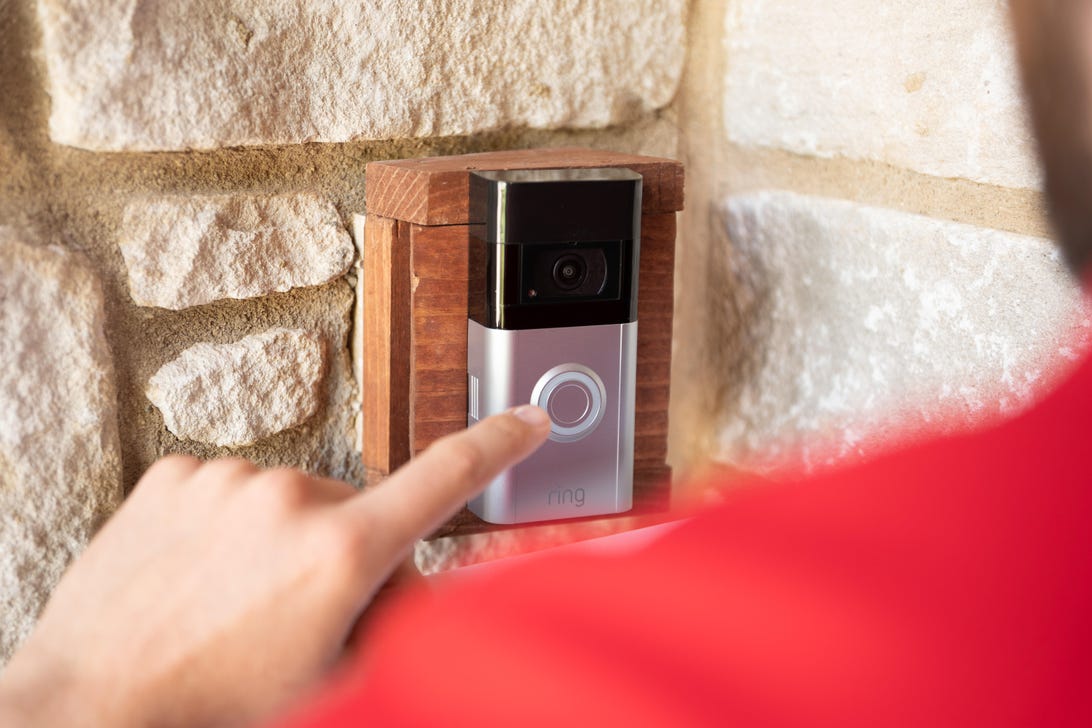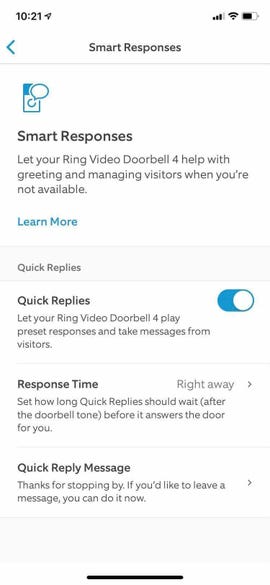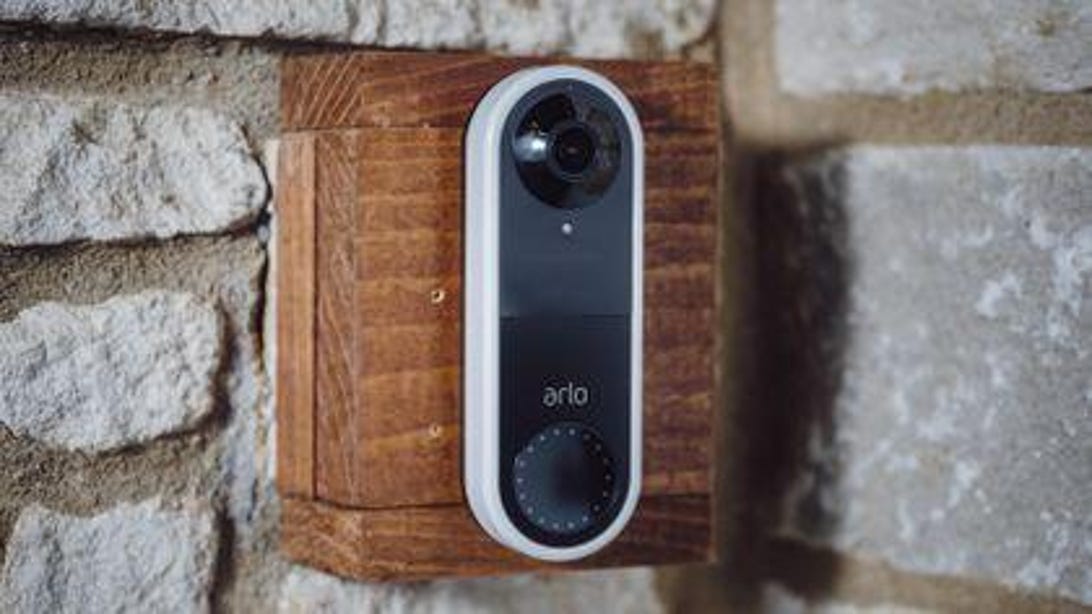Editor's note: Ring has been called out for its partnership with local police departments in the US, leading privacy advocates to express concern about the data Ring shares with law enforcement and how they use that information. In December 2019, thousands of Ring users' personal information was exposed, leading us to stop recommending Ring products. Ring has since updated its security policies, mandating two-factor authentication, adding end-to-end video encryption and introducing CAPTCHA and authenticator app support.
When it comes to reviewing gadgets like the Ring Video Doorbell 4, a developer's policies regarding customer data -- and how they've carried out such policies in the past -- are every bit as consequential as devices' physical dimensions, video quality specs, radio frequencies and other technical features.
Like
- Color preroll captures more video
- Quick Replies let visitors leave a message
- Integration with Alexa
Don't Like
- Ring's association with police
- Wide-angle camera view
- No "wired" mode
The $200 (£179) Ring 4 is clearly a well-built smart doorbell. Behind its iconic silver faceplate, there's a 1080p camera with a 160-degree field of view, two-way audio that connects to your smartphone, laptop and Amazon smart display, and motion detection with alerts.
Plus it has extra features to help justify its premium price tag: Quick Replies (think old-school answering machine, "leave a message"), full-color preroll recording (giving you a few seconds of low-res video from before a motion event), adjustable motion zones and dual-band Wi-Fi (2.4GHz and 5GHz), to name a few.
But for anyone considering upgrading from the Ring Video Doorbell 3 Plus, the value proposition isn't so hot. With the Ring 4, you get color preroll footage versus black and white on the Ring 3 Plus. Owners of the Ring Video Doorbell 2 may have slightly more incentive to upgrade -- they don't have any preroll feature at all. Neither previous-gen device has dual-band Wi-Fi, but if you don't have any connectivity problems you don't really need it. Those are about the only differences.

The Ring Video Doorbell 4 is a good video doorbell, but the company that makes it hasn't always been a great corporate citizen.
RingThe bigger question for many potential customers isn't just whether the Ring 4 is a quality gadget (it is) or whether you should upgrade from an older Ring (probably not), but whether a company with both financial and operational ties to law enforcement should be entrusted to safeguard a treasure trove of personal, private information that includes video footage of you, your family, your friends and your neighbors.
That's where the Ring narrative, as always, gets a little dicey.
A brief history of Ring's relationship with the police
Back in 2019, details emerged that Ring had made arrangements granting criminal investigators across the country access to so-called "heat maps" showing the distribution of Ring doorbell cameras throughout their precincts. Ring also created a mechanism by which police could request access to the footage captured by those cameras, then exercised what many argued was recklessly lax oversight of that very process.
That this controversy came to light and continued to unfold during a period of national and international reckoning over widespread, institutionalized abuse of police powers didn't help Ring's deteriorating reputation.
Much has changed in the last two years, including Ring's policy for cooperating with the police, which now directs investigators to ask neighborhood residents publicly and directly for access to their doorbell camera recordings via the Neighbors app. While this doesn't disable the apparatus that allows for potential police overreach, it shifts watchdog responsibilities from Ring to the communities themselves.
If you're OK with all that -- and you're in the market for a $200 video doorbell (and don't already have one) -- then you might consider the Ring 4. But there are other, similarly priced options just as worthy of your attention that don't carry any of Ring's baggage -- and come with better features, to boot.
I'll get to those in a bit, but first let's have a look at the basics.

The Ring 4 looks just like its predecessors -- but it packs in more smarts than before.
Chris Monroe/CNETRing invented the smart doorbell, and it shows
The Ring 4 looks just like every previous iteration of the iconic doorbell camera, but that's kind of a good thing. Ring offers faceplates in a variety of colors and finishes to match your home's exterior décor, which is fine if you want your doorbell camera to blend in. If you'd like to at least fire off a warning shot for any would-be porch pirates, nothing communicates, "Smile, you're on camera" quite like the look of the OG doorbell cam.
Installation is a breeze, whether you currently have a wired doorbell or not. If you do, great -- you can wire the Ring 4 and never worry about charging the battery. If not, no worries -- the battery detaches and recharges in a matter of hours. By adjusting a few settings, a full charge could last you months. (Those would include turning on Advanced Motion Detection to end recordings as soon as motion stops, setting motion frequency for "Periodically," and turning off Snapshot Capture, HDR and Live View.)
You can either purchase a separate Ring doorbell chime for $30 or, if you've got an Alexa device or two (or 10), you can link your Ring doorbell camera to Amazon's voice assistant, and your Echo smart speakers will play a chime whenever someone rings the doorbell. (Alternatively, you could just let the app push a notification to your phone when someone's at the door and forget the rest.)
Beyond that, it does just what you'd expect a video doorbell to do -- people come to the door, ring the doorbell; then you can see them and talk to them over the intercom. By default, the Ring 4 will record these interactions, but you can also set it to record whenever it detects any kind of motion (and whether to notify you or not when it does).
Interfacing with Ring, whether through the mobile app, Alexa or on an internet browser, is simple and intuitive, although in terms of latency (i.e., the amount of time it takes to connect to the doorbell camera) the connection can feel a bit laggy at times. That's kind of par for the course with an always-on camera designed to run on battery. Wiring the device doesn't seem to solve the problem, however, nor did the dual-band Wi-Fi seem to make much of a difference in my setup.
Putting the Ring 4 through the ringer

Quick Replies let your doorbell field visitors on your behalf.
Screenshot by David Priest/CNETFor several weeks starting in late spring, I put the Ring 4 through the paces. I held dozens of real-time conversations with both humans and (full disclosure) a few neighborhood dogs, all using the intercom feature with either my iPhone or an Alexa device.
On one occasion, I even told a caller that I was upstairs and would retrieve the package later, even though in reality I was several states away. (I was low-key worried they might not leave the package -- which I should've had forwarded -- if they knew I wasn't home.)
I even had a handful of those automated "Quick Reply" interactions I mentioned earlier -- like when the pizza delivery person ignored the no-contact instructions and rang my doorbell anyway. ("Um, your pizza's here.") That feature isn't available on the base model $100 Ring Video Doorbell, but you already have it if you own any of the previous-gen versions of Ring's premium video doorbells (any of the numbered iterations, either of the Pro models or the Peephole). I found it invaluable.
I also spent hours poring over recorded video -- often trying to timestamp events, like the last time I took my dog out or what time a friend left my house. That's when I came to really appreciate the preroll feature, which captures a few seconds of low-res footage prior to the triggering motion event.
It isn't just a perk -- it's practically a necessity if you want to know what really happened in some instances, like, say, when the wind blows over the rain-soaked dog bed you'd leaned against the porch railing to dry. Color preroll is only available on the Ring 4 and Ring Pro 2 -- the Ring 3 Plus has it too, but in black-and-white.
There's another video doorbell on the market -- the Arlo Video Doorbell -- with a similar feature, called Foresight. That's one reason Arlo remains CNET's top pick for best overall video doorbell, but before I dive into that comparison, let's take a look at what bells and whistles the Ring 4 might be missing.
Features notably absent from Ring 4
I get a lot of packages delivered, both as a tech reviewer and shopaholic. It's one of the biggest reasons I need a doorbell camera. Although a steel gate blocking entry to my front porch gives me an extra line of defense against porch pirates, I'd still like to be able to see packages with my doorbell camera.
That's the first task the Ring 4 utterly fails at. While the Ring 4's 160-degree horizontal field of view is more than enough to let me see both ends of my porch, its far narrower 84-degree vertical field of view means I can angle the camera to capture visitors' faces or packages left on my porch stoop -- but not both.
The Ring's 16:9 aspect ratio may be perfect for watching video clips, but it's woefully inadequate for keeping an eye on your packages. With both the Ring 4 and the Ring 2 before it, I chose to mount the camera so it could see callers' faces. I then had to trust delivery notifications, cross-referenced with motion alerts of delivery drivers dropping off my packages.

The Arlo Video Doorbell's 1:1 aspect ratio means you can see packages left right on your doorstep -- as opposed to the Ring 4.
Chris Monroe/CNETBoth the Ring Pro 2 and both the wired and wireless models of the Arlo Video Doorbell solve this problem by offering cameras with a 1:1 aspect ratio. (Arlo even further bends the space-time continuum with its magnanimous 180-degree field of view in both directions.)
Speaking of packages, even if you angle the Ring 4 so it can see your front stoop, it still can't notify you when there's a package on it. The Arlo Video Doorbell, on the other hand, offers package, person, animal and even vehicle detection.
The wireless version of the Arlo doorbell camera costs $200 -- same as the Ring 4 -- and the premium subscription that gets you those added features (object detection and more) also costs about the same as Ring's: $3 per month for a single camera; $10 for multiple cameras.
Another similarly priced option that has the advantage of Apple HomeKit compatibility is the (also $200) Logitech Circle View Doorbell Camera. It adds facial recognition to let you know who's at your door and has a portrait-oriented 4:3 aspect ratio that still offers 160 degrees of view, left to right. The Logitech doorbell camera is only available as a wired option, however.
The dealbreaker, if there is one
Like many people who write about smart home tech, I'm not thrilled that Ring continues to cooperate with police to the extent it does -- especially since no other similar apparatus seems to exist at Google Nest, Logitech, Arlo or any other company that makes doorbell cameras. I'm glad Ring has put the request process for camera footage closer to where it belongs, in the public square. It's a step in the right direction, but it isn't all the way there just yet.
Accordingly, our approach to how we cover Ring at CNET has evolved as well. You can read the rest of our Ring coverage aggregated here, but the takeaway is that, while Ring has definitely made strides toward stronger security, its ongoing police partnerships -- and their centrality to Ring's business -- remain troubling to say the least.
Because of this, we will include Ring products in our recommendations in a given category's list of best devices (when the technology and price warrant it), but not award Editor's Choice awards until the police partnerships have been more substantively limited.
Ring 4's features don't disappoint, but you have better options
If you've been thinking about getting the Ring 4, you'll probably be happy with this device -- as long as you're comfortable with Ring's policy regarding police. It's a solid doorbell camera that offers a good value for the price.
That said, the Arlo Video Doorbell and the Logitech Circle View Doorbell both offer slightly better features for the same price as the Ring 4. And when you factor in those other controversies, it makes the decision that much clearer. The Ring 4 is a good piece of hardware -- but it's not the best wireless video doorbell on the market.
"gadget" - Google News
July 22, 2021 at 11:00PM
https://ift.tt/2V2mruD
Ring Video Doorbell 4 review: A competent gadget from a company with a shaky reputation - CNET
"gadget" - Google News
https://ift.tt/2ykEYqK
Bagikan Berita Ini
















0 Response to "Ring Video Doorbell 4 review: A competent gadget from a company with a shaky reputation - CNET"
Post a Comment